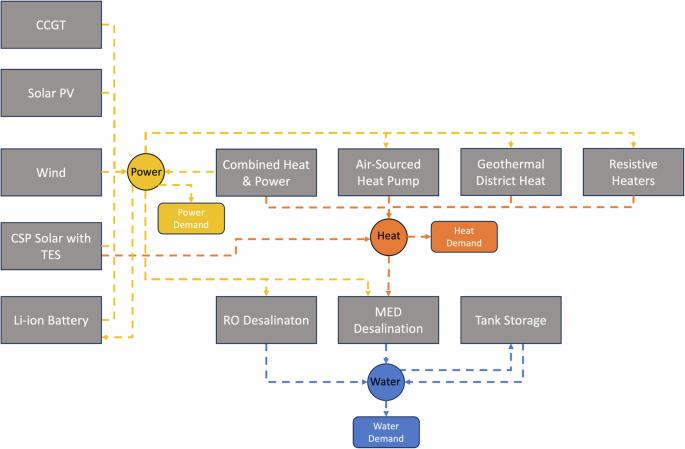应对极端天气事件,促进沙特阿拉伯内奥姆的可再生能源发电、供水和供热行业发展
IF 8.1
1区 地球科学
Q1 ENVIRONMENTAL SCIENCES
引用次数: 0
摘要
提出了一种可再生能源设计优化模型,用于规划电力、水和热能技术的投资。可再生能源的间歇性要求这些模型在高空间和时间分辨率下捕捉资源的变化和互补性。然而,大多数规划模型都使用时间序列还原法,这种方法在捕捉数据差异的同时,往往会抹平极端天气或需求模式。为了考虑极端模式并设计可靠的能源系统,我们提出了一个考虑极端天气的聚类优化框架。该框架被应用于沙特阿拉伯 Neom 地区多部门综合能源系统的设计。我们的研究结果表明,在没有考虑极端天气的情况下设计的完全可再生能源系统无法满足需求,在优化后的模拟中反而需要外部电力或水供应。一旦在优化过程中考虑了极端日,系统的可靠性就会提高,但代价是需要投入更多的发电和储能成本。在沙特阿拉伯的 Neom 地区,根据结合成本和技术参数以及可再生资源可用性的数据驱动方法,在不考虑极端天气日的情况下设计的可再生能源发电系统无法满足需求,而需要外部能源或水供应。本文章由计算机程序翻译,如有差异,请以英文原文为准。

Addressing extreme weather events for the renewable power-water-heating sectors in Neom, Saudi Arabia
A renewable energy design optimization model is proposed to plan investments in power, water, and heat technologies. The intermittent nature of renewables requires that these models capture the variability and complementarity of resources at high spatial and temporal resolutions. However, most planning models use time-series reduction methods that, while capturing data variance, often smooth out extreme weather or demand patterns. To account for extreme patterns and design reliable energy systems, we propose a clustering-optimization framework that considers extreme weather days. This framework is applied to design an integrated multi-sector energy system for the Neom region in Saudi Arabia. Our results show that fully renewable systems designed without considering extreme days could not meet demands and instead required external power or water supplies during a post-optimization simulation. Once extreme days were considered in the optimization, system reliability increased at the expense of larger generation and storage capacity investments. In the Neom region of Saudia Arabia, renewable power systems designed without considering extreme weather days do not meet the demands and require external energy or water supplies according to the data-driven approach combining cost and technical parameters and renewable resource availability.
求助全文
通过发布文献求助,成功后即可免费获取论文全文。
去求助
来源期刊

Communications Earth & Environment
Earth and Planetary Sciences-General Earth and Planetary Sciences
CiteScore
8.60
自引率
2.50%
发文量
269
审稿时长
26 weeks
期刊介绍:
Communications Earth & Environment is an open access journal from Nature Portfolio publishing high-quality research, reviews and commentary in all areas of the Earth, environmental and planetary sciences. Research papers published by the journal represent significant advances that bring new insight to a specialized area in Earth science, planetary science or environmental science.
Communications Earth & Environment has a 2-year impact factor of 7.9 (2022 Journal Citation Reports®). Articles published in the journal in 2022 were downloaded 1,412,858 times. Median time from submission to the first editorial decision is 8 days.
 求助内容:
求助内容: 应助结果提醒方式:
应助结果提醒方式:


